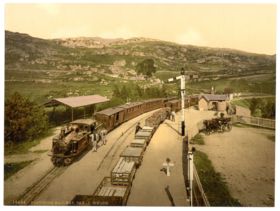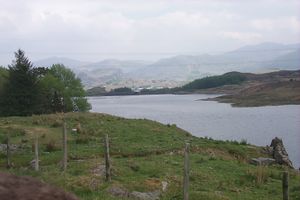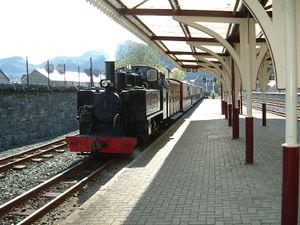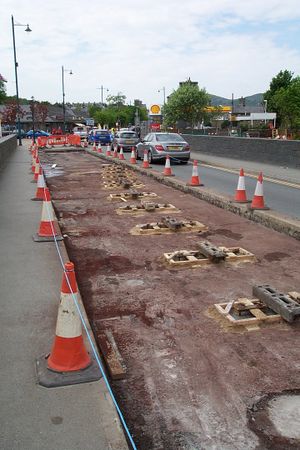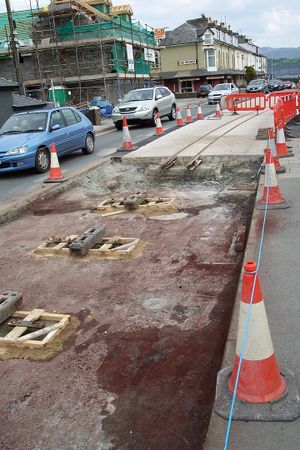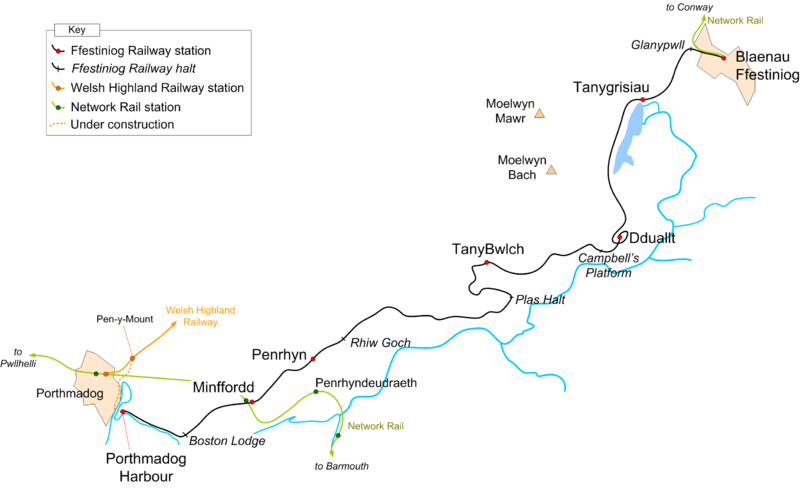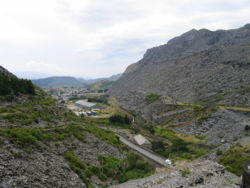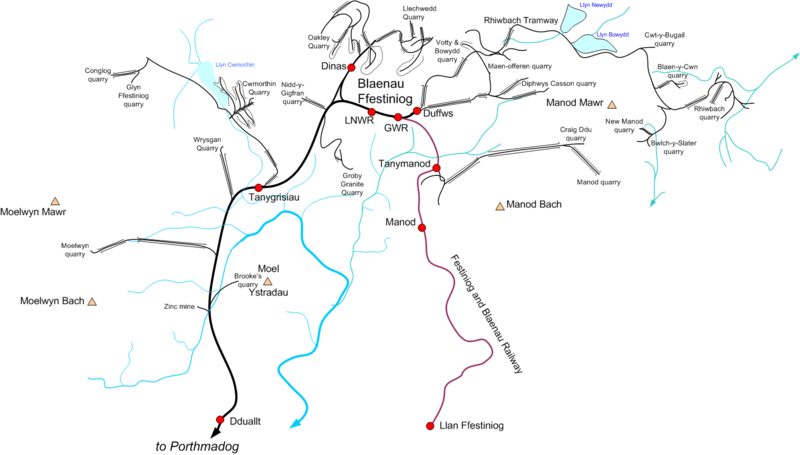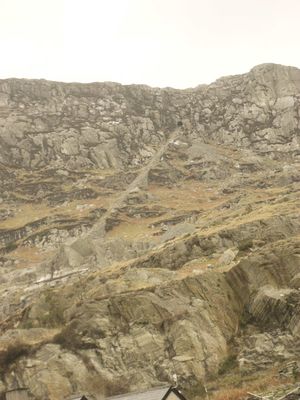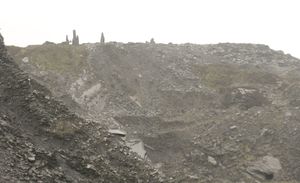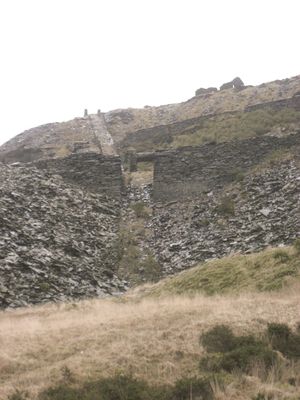Ffestiniog Railway
| Ffestiniog Railway | |
|---|---|
| Two trains passing at Tan-y-Bwlch, ca. 1900 | |
| Location | |
| Place | Wales |
| Terminus | Porthmadog |
| Commercial Operations | |
| Name | Festiniog Railway Company |
| Built by | Festiniog Railway Company |
| Gauge | 1 ft 111⁄2 in (597 mm) |
| Preserved Operations | |
| Operated by | Festiniog Railway Company |
| Stations | 10 |
| Length | 13.5 miles |
| Gauge | 1 ft 111⁄2 in (597 mm) |
| Commercial History | |
| Opened | 1836 |
| Closed | 1 August, 1946 |
| Preservation History | |
| 1954 | Restoration started at Boston Lodge works 20 September 1954 |
| 1955 | Reopened to Boston Lodge 23 July 1955 |
| 1956 | Reopened to Minffordd |
| 1957 | Reopened to Penrhyn |
| 1958 | Reopened to Tan-y-Bwlch |
| 1965 | Start of the Deviation construction work |
| 1968 | Reopened to Dduallt |
| 1974 | Restoration of Rhiw Goch passing loop |
| 1977 | Reopened to Llyn Ystradau |
| 1978 | Reopened to Tanygrisiau |
| 1982 | Reopened to Blaenau Ffestiniog |
The Ffestiniog Railway (in Welsh Rheilffordd Ffestiniog) is a narrow-gauge heritage railway, located in North West Wales. It is a major tourist attraction mainly within the Snowdonia National Park.
The railway is about 13.5 miles (21.5 km) long and runs from the harbour at Porthmadog to the slate mining town of Blaenau Ffestiniog. The line travels through spectacular mountainous scenery and is single track with passing places. The track gauge is 1 ft 111⁄2 in (597 mm). The first part of the line runs along a mile-long embankment called "the Cob", which is the dyke of the Traeth Mawr "polder". The Cob was built between 1807 and 1811 by William Madocks and in addition to its land reclamation function in conjunction with sluice gates at the Britannia bridge, serves also as a roadway (since 1836 this has been at a lower level on the landward side) and a bridge across the Afon Glaslyn. Tolls were charged with a tollgate at Boston Lodge until 2003, when the rights were purchased by the National Assembly for Wales. The higher, original, section of the Cob carries, in addition to the railway, a public footpath throughout virtually its entire length. There is no fencing between the footpath and the railway.
52.958802, -3.936329, Ffestiniog 52.916221, -4.107306, Porthmadog, Gwynedd LL49 </googlemap>
Contents
History
The railway company is properly known as the "Festiniog Railway Company", and this contemporary anglicised spelling is still the official title of the company as defined by the Act (2 William IV cap.xlviii) that created the railway. It is the oldest surviving railway company in the world, having been founded by the Act of Parliament on 23 May 1832 with capital mostly raised in Dublin by Henry Archer, the company's first secretary and managing director. Most British railways were amalgamated into four large groups in 1921, and then into British Railways in 1948, but the Festiniog Railway Company, in common with most narrow gauge railways, remained independent: in 1921 this was due to political influence, whereas in 1947 it was left out of British Railways because it was closed for traffic despite vigorous local lobbying for it to be included.
Horse and gravity operation
The line was constructed between 1833 and 1836 to transport slate from the quarries around the inland town of Blaenau Ffestiniog to the coastal town of Porthmadog, where it was loaded onto ships. The railway was graded so that loaded wagons could be run by gravity downhill all the way from Blaenau Ffestiniog to the port. The empty wagons were hauled back up by horses, which travelled down in special 'dandy' wagons. To achieve this continuous grade (about 1 in 80 for much of the way), the line followed natural contours and employs cuttings and embankments built of slate blocks without mortar. Prior to the completion in 1844 of a long tunnel through a spur in the Moelwyn Mountain, the slate trains were worked over the top via inclines (designed by Robert Stephenson) which can still be seen.
Up to six trains daily were operated in each direction, and a printed timetable was published on September 16 1856 by Charles Easton Spooner who, following his father, served as Manager and Clerk for 30 years. It shows departures from the "Quarry Terminus" (at that time Dinas Junction) at 7:30, 9:28, 11:16, 1:14, 3:12 and 5:10. Trains waited ten minutes at the intermediate stations called "Tunnel", "Hafod Llyn" and "Rhiw Goch". The fastest journey time from Quarry Terminus to Boston Lodge was 1 hour 32 minutes, including three stops. From Boston Lodge the slate wagons were hauled to and from Porthmadog harbour by horses. Up trains took nearly six hours from Boston Lodge to the Quarry Terminus, and each train ran in up to four sections, each hauled by a horse and comprising eight empty slate wagons plus a horse dandy. This timetable gave a maximum annual capacity of 70,000 tons of dressed slate.[1] Two brakesmen travelled on each down train, controlling the speed by the application of brakes as needed. At passing loops trains passed on the right and this continues to be a feature of Ffestiniog Railway operation.
There is evidence for tourist passengers being carried as early as 1850, without the blessing of the Board of Trade, but these journeys would also observe the timetable.
Steam and gravity operation
In October 1863 steam locomotives were introduced, to allow longer slate trains to be run, and this also enabled the official introduction of passenger trains in 1865: the Ffestiniog was the first narrow-gauge railway in Britain to carry passengers. In 1869 the line's first double Fairlie articulated locomotive was introduced, and these double-ended machines have since become one of the most widely recognised features of the railway.
Down trains continued to run entirely by gravity, but faster up journeys and longer trains increased line capacity. A new timetable dated October 1863 shows six departures daily from each terminus at two hour intervals, starting at 7:00 am and taking 1 hour 50 minutes including stops (totalling 20 minutes) at Tanygrisiau, Hafod-y-Llyn and Penrhyn. Trains passed only at Hafod-y-Llyn (from 1872 Tan-y-Bwlch). When passenger services started, the usual practice was for locomotive hauled up trains to consist of loaded general goods and mineral wagons, followed by passenger carriages, followed by empty slate wagons with brakesmen. Down trains were run in up to four separate (uncoupled) portions: loaded slate wagons, goods wagons, passenger carriages and finally the locomotive running light. This unusual and labour intensive method of operation was short lived and eventually the passenger and goods portions were combined into a single train headed by the locomotive.
The loaded slate trains continued to operate by gravity until the end of passenger services in 1939. Slate trains eventually became very long - trains of less than eighty slate wagons carried two brakesmen, but over eighty wagons (and this became common) required three brakesmen. About one wagon in every six was equipped with a brake, the others were unbraked. Trains continued to pass at Tan-y-Bwlch and to a lesser extent at Minffordd. The Summer timetable for 1900 had nine trains daily in each direction, and trains had been accelerated to one hour from Porthmadog to Duffws including stops at Minffordd, Penrhyn, Tan-y-Bwlch, Dduallt (request), Tanygrisiau, Blaenau (LNWR) and Blaenau (GWR). Speeds in excess of 40 mph were then normal.[2]
The original passenger coaches (some of which still survive) were small four wheeled vehicles with a very low centre of gravity. In 1872 the FR introduced the first bogie carriages to operate in Britain. The continuous vacuum brake was installed in 1893. The line was fully signalled with electric telegraph and staff and ticket working. Electric Train Staff instruments were introduced in 1912 and they continue in use to the present day.
Decline of slate and development of tourism
By the 1920s the demand for slate as a roofing material dropped owing to the advent of newer materials and to the loss of the overseas trade in World War I. As a result, the railway suffered a gradual decline in traffic.
In 1921 the Aluminium Corporation at Dolgarrog in the Conwy Valley bought for £40,000 a controlling interest in the FR and Henry Jack became Chairman, the FR company's financial administration moving to Dolgarrog. Jack was also chairman of the new Welsh Highland Railway and was instrumental in getting government backing for its completion on the understanding that the FR and the WHR would be jointly managed from Porthmadog, with maintenance undertaken at Boston Lodge and with other economies of scale. In 1923, the FR line was joined to the WHR line at a station called "Portmadoc New". The Welsh Highland line was almost totally dependent on tourism and this proved slow to develop.
To gain additional expertise in light railway operation which was being introduced on the FR and WHR to cut operating overheads, Colonel H. F. Stephens was in 1923 appointed part-time as Engineer to both companies. Stephens became Chairman and Managing Director of both companies in 1924. When the WHR was taken into receivership in 1927, Colonel Stephens was appointed as Receiver for the WHR and financial administration of both companies moved to Tonbridge in Kent. The fortunes of the WHR, despite great efforts, failed to improve and it became bankrupt in 1933. In order to protect their investments, the joint owners of both companies arranged for the WHR to be leased by the FR, but the WHR losses continued and it closed in 1937.
The FR continued to operate its slate traffic, a workmen's train on weekdays throughout the year and a summer tourist passenger service. Ordinary passenger services ceased on the FR on 15 September 1939, shortly after the outbreak of World War II. The workmen's passenger service ran for the last time on Saturday 16 September 1939. Slate trains were from then onwards operated three days each week, but gravity operation was discontinued. Slate traffic ceased on 1 August 1946, apart from the section from Duffws to the North Western yard through Blaenau Ffestiniog town centre, which was leased on 7 October 1946 to the quarry owners. This provided the railway company, which retained the services of a resident manager at Porthmadog, with a small income throughout the moribund years.
The original Act of Parliament, which permitted the building of the line, made no provision for its closure or abandonment. Although the main line had ceased functioning, the company could not dismantle the railway, so the track and infrastructure were left in place. However, without maintenance it soon became overgrown and unusable.
Restoration
From 1949, various groups of rail enthusiasts attempted to revitalise the railway. Eventually, on 24 June 1954 a group of volunteers funded by Alan Pegler purchased the company to run it as a tourist attraction, and gradually restored the line to working order. This was not helped by a decision by the Central Electricity Generating Board (CEGB) in 1954 to build the Ffestiniog Pumped Storage Scheme, including the Tan y Grisiau reservoir (Llyn Ystradau), which flooded part of the northern end of the line. The Festiniog Railway Company was able to obtain compensation in 1972, after the second-longest legal battle in British legal history, having taken eighteen years and two months. Two years later, as a result of the case, the British Parliament passed the Land Occupancy Act 1973.
On 18 August 1954, prior to commencing the restoration, in an inspection, the first of many, Colonel McMullen of the Ministry of Transport, Railways Inspectorate, accompanied by Alan Pegler, several directors and other supporters walked the line from Blaenau Ffestiniog to Porthmadog. The work of restoration began on 20 September 1954 when Morris Jones, the foreman fitter who had last worked for the railway in March 1947, rejoined the staff to complete the rebuilding of the locomotive 'Prince' on which he had been engaged when the works closed. He was joined at Boston Lodge works by two volunteers, Bill Harvey and Allan Garraway.[3] 6 November 1954 marked the completion of sixty years service with the FR of Robert Evans (for almost 25 years as Manager) and a special train was run (with difficulty) from Minffordd to Porthmadog to celebrate the occasion and convey Mr Evans, his wife, Alan Pegler (Company Chairman) and guests en route to a clock presentation ceremony.[4] Mr Evans continued in service as Manager until his retirement on 1 June 1955 when Allan Garraway was appointed as Manager.
The first public passenger train from Porthmadog to Boston Lodge ran on 23 July 1955. Prince returned to service on 3 August 1955 and, following extensive boiler repairs, Taliesin, then the latest of the FR Fairlie articulated engines, returned to service on 4 September 1956. The passenger service was extended to Minffordd on 19 May 1956, to Penrhyn on 5 June 1957 and to Tan-y-Bwlch on 5 April 1958. Increasing traffic was putting severe demands on the track - over seven miles had been reopened in four years. A long period of consolidation, rolling stock restoration and track renewal followed before the extension to Dduallt on 6 April 1968. Extension to Dduallt was celebrated on 28 May 1968 by the re-introduction of the Ffestiniog Railway Letter Service.
The Llyn Ystradau Deviation
Between 1965 and 1978, the Ffestiniog Railway Deviation, that 2½ mile long diversionary route was constructed between Dduallt and Tanygrisiau in order to avoid the works of Tanygrisiau hydro-electric power station and its reservoir (Llyn Ystradau). The Deviation (this is the conventional name for such railway works) was built mostly by volunteers. At the southern end is the spectacular Dduallt spiral formation (unique on a public railway in the United Kingdom). It was constructed with its bridge entirely by volunteers and gains an initial height rise of 35 feet in order (after a further mile of new volunteer built railway and a new tunnel) to clear the flooded track bed north of the former Moelwyn tunnel, which is plugged near its normally submerged northern end. Parts of the trackless former route can be clearly seen below the new route between Dduallt and the old tunnel.
The new 310 yard long tunnel was constructed (between 1975 and 1977) by three Cornish tin mining engineers with a small team of employees. It had to be blasted through a granite spur of the Moelwyn mountain. The tunnel plant included stone crushing and grading plant to produce track ballast and other aggregates from the spoil for use on the railway. Following completion the new tunnel first had to be lined throughout its length with liquid cement reinforced with steel mesh in a process called 'shotcreting'.
A pull and push service officially called The Shuttle and powered by diesel locomotive Moel Hebog with carriage 110 was operated from Dduallt to Gelliwiog from 26 May 1975, during two summers, to enable tourists to experience the Deviation route in advance of the opening of the new Moelwyn Tunnel.
North of the new tunnel is a long stretch along the west bank of the new reservoir. Full-length passenger trains first ran from Dduallt through the new tunnel to a temporary terminus known as Llyn Ystradau (now dismantled) on 25 June 1977. This station was alongside the Tanygrisiau reservoir, but passengers could not leave the station other than by train as it was on Central Electricity Generating Board land without public access.
The remaining section included some specialised engineering work at its summit where the new line passes over the power station pipelines. This was followed by two public road crossings with automatic signalling, during a fall in height to rejoin the old route in Tanygrisiau station, which was reopened on 24 June 1978.
The largely volunteer group building the Deviation was officially called the Civil Engineering Group, but its members were popularly known (and are still remembered) as the Deviationists who completed an enormous task over 13 years.
Project Blaenau
The completion of the railway through to Tanygrisiau left the FR with just one and a half miles to go to its goal of Blaenau Ffestiniog but the complexities of reconstructing that unique but very derelict urban section of narrow gauge railway took a further four years. As well as 1½ miles of new track and its formation, which was the responsibility of the FR permanent way department and its volunteers, much other work needed to be done. Most of the work, like the deviation itself, was undertaken by volunteers who in many cases assumed full responsibility for the design as well as the execution of discrete projects, each under a volunteer project leader. There were four decrepit footbridges each needing to be demolished and rebuilt to the new FR loading gauge. The primitive railway bridge across the Afon Barlwyd required total replacement but in similar form. Walls and fences throughout had to be repaired or replaced. These and the many other varied tasks formed Project Blaenau.
One major task near Tanygrisiau was the responsibility of Gwynedd County Council, which had at some time after 1955 taken advantage of the absence of trains to demolish what was probably Britain's lowest road under railway bridge. In early 1980, therefore, they replaced Dolrhedyn bridge and even managed to give it a few inches extra headroom for road vehicles.
Civil engineering contractors were employed in conjunction with British Rail and Gwynedd County Council for the new route with its bridges and roadworks and the new joint station on the former Great Western Railway station site. British rail commenced using the new station on 22 March 1982. Ffestiniog trains returned to Blaenau on Tuesday, 25 May 1982, thus marking the 150th Anniversary of Royal Assent to the Festiniog Railway Act of 1832. The new joint station with British Rail at Blaenau Ffestiniog was officially opened on 30 April 1983 by George Thomas, Speaker of the House of Commons, who unveiled a plaque that records his visit.
With the major project of track restoration to Blaenau finally complete, attention could be turned to other matters. More Fairlie locomotives were built or restored, and new carriages were built. At Minffordd a new hostel was built for volunteers, who support the permanent staff by working in every department of the railway. Stations were given new buildings, canopies and platforms, often replacing the previous temporary structures, and improving the image of the railway for the future.
Welsh Highland Railway
- main article Welsh Highland Railway
In 1988 the Festiniog Railway Company was involved in a controversial plan to stop the neighbouring Welsh Highland Railway (WHR) being rebuilt as it was concerned at the effect a nearby heritage railway competitor could have on the FR business. The initial plan would have involved the FR Company buying the original track bed of the WHR from the old company's receiver and giving it to Gwynedd County Council, provided no railway-related developments were allowed on the land. This was greeted with dismay by the WHR (1964) Company which had been attempting to preserve the line since the 1960s.
This action may have delayed the start of rebuilding of the Welsh Highland Railway, although the alternative plan was dependent on the continued co-operation of Gwynedd council to assure that the track bed was used solely for railway purposes. This was not guaranteed, as pressure from various groups who objected to the rebuilding of the railway was significant and it was the stated intention of the council to apply for an abandonment order on gaining the track bed. This would have left the track bed open for use in other ways such as footpaths, road improvement schemes etc. as the statutory designation of the track bed as a railway would have been discontinued. Over the years, the presence of plans for footpaths and roads had indeed made it difficult for anyone wishing to rebuild the line.
This led a group to form called 'Trackbed Consildation Limited' (TCL) and after some detective work, TCL managed to trace and purchase shares and debentures in the original WHR company. They felt that an alternative plan was available, one where the original company could be brought out of receivership. It was originally the intent of TCL to provide the track bed to the WHR (1964) Company to rebuild the line.
TCL were introduced to the FR and decided that the aims and objectives of TCL and the FR were similar, thus since 1990 the FR company has been totally committed to the reopening of the Welsh Highland Railway. All TCL-owned shares/debentures were transferred to the FR.
The next few years were marked by protracted legal procedures before the assets of the old company could be transferred and before final consent to rebuild the railway was given. The first section from Caernarfon to Dinas was opened and operated by the FR on 11 October 1997. This section was not hampered by these extended legal procedures and was built as a Light Railway Order, as it was not part of the original Welsh Highland Railway route and the site of Dinas station had been sold off and thus was not part of the assets of the old WHR company.
Restoration to Waunfawr was completed in 2000 and to Rhyd Ddu in 2003. Reconstruction of the remaining section through to Porthmadog is in progress from both ends. Track has already reached the Beddgelert Forest and works are in evidence as far south as Bryn-y-felin.
The completed Welsh Highland Railway, or Rheilffordd Eryri (its Welsh name), will comprise parts of the former London and North Western Railway (1867), North Wales Narrow Gauge Railways (1877-81), Portmadoc, Beddgelert and South Snowdon Railway and Welsh Highland (1922-3) Railway. In 2009 the Ffestiniog Railway intends to reconnect with the rebuilt Welsh Highland Railway at Harbour Station, linking Caernarfon to Porthmadog. The FR will also link with the WHR (Porthmadog) at Pen-y-Mount Station, north of Porthmadog.
Construction in 2008
A visit to Porthmadog in May 2008 showed construction of the link well under way. The vehicle toll may well have been suspended to allow for the delays caused by running the track across the main road.
Tourism and heritage
One of the earliest references to tourism is in the LNWR Tourist Guide for 1876, which waxed lyrical about the Ffestiniog Railway, which it illustrated with a drawing of a lady in Welsh national dress (then still in regular local use) travelling on an FR up train (since many empty slate wagons – with two standing brakesmen – were attached at the rear) with the caption "On the Ffestiniog Railway". The guide uses the "double F" spelling throughout.[5] It was, however, in the inter-war years from 1919 to 1939 that tourism, though always valued, came to acquire a major importance.
Since restoration commenced in 1954, tourism has been the only significant source of income. The role of the Ffestiniog Railway in the promotion and fulfilment of tourism and in preserving railway heritage has been recognised many times, and notable mentions have included:
- 1964 Wales Tourist Board certificate for conspicuous service to Welsh tourism.[6]
- 1972 Wales Tourist Board lists the FR as fifth most popular tourist site in Wales, after Caernarfon Castle, the Swallow Falls, the National Museum of Wales at Cardiff and Conwy Castle.[7]
- 1979 The FR was one of only six sites in Wales to receive the British Tourist Authority’s Golden Jubilee Award.[8]
- 1987 The FR was the outright winner of the Independent Railway of the Year award.[9]
- 2004 The "Talking Train" was awarded the Heritage Railway Association 'interpretation' Award.[1]
Recognition of the railway’s importance to tourism and heritage has been increasingly marked by financial assistance given to the company towards capital expenditure. Prior to September 1987, the FR had received £1,273,127 in gifts and grants. Of this: £450,476 was Gifts from the FR Society and FR Trust and other supporters; £379,335 from Wales Tourist Board; £134,320 from EEC Grants and £308,996 from other public sources.[10]
Major grants received subsequently have been: In 1989 a grant of £430,000 mainly from The EEC (National Programme of Community Interest for the promoting of tourism in Dyfed, Gwynedd and Powys);[11] in 1995 a grant of £500,000 to promote work in Blaenau Ffestiniog[12] and in 1998 a Heritage Lottery Fund grant of £375,000 for the construction of workshops to facilitate the restoration of historic vehicles.[13]
Stations and halts
| Station | Place | Image | Opened | Closed | Distance from Porthmadog | Notes |
|---|---|---|---|---|---|---|
| Porthmadog Harbour | Porthmadog | 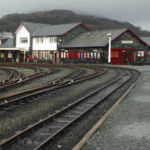
|
1865 | Open | 0 | Junction with the original line from across the Britannia bridge (see note at the end of this table) |
| Pen Cob Halt | Boston Lodge | 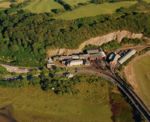
|
1956 | 1967 | 70 chains | opened 19 May 1956 used regularly only until 5 November 1957. |
| Boston Lodge | Boston Lodge | 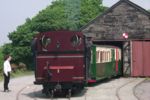
|
1928 | Open | 1 mile 5 chains (1.71 km) | temporary terminus 23 July 1955 to end of 1955 season. |
| Minffordd | Minffordd (near Portmeirion) | 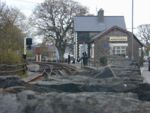
|
1872 | Open | 2 miles 5 chains (3.31 km) | Joint station with the Cambrian Line. Temporary FR terminus 19 May 1956 to end of 1956 season. |
| Cae Ednyfed | Minffordd (near Portmeirion) | 1836 | 1863 | 2 miles 7(?) chains | There were stables here between 1836 and 1863 and this was a horse stage station. | |
| Pen y Bryn Halt | Penrhyndeudraeth | 1957 | 1967 | 2 miles 63 chains | opened 20 April 1957 used regularly only until 5 November 1957. | |
| Penrhyn | Penrhyndeudraeth | 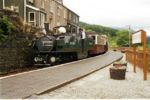
|
1865 | Open | 3 miles 8 chains (4.99 km) | temporary terminus 20 April 1957 to 5 November 1957. |
| Rhiw Goch | Penrhyndeudraeth | 1836 | Open | 4 miles 16 chains (6.76 km) | Passing loop for horse-drawn trains until 1863. Re-instated as a passing loop in 1975. | |
| Plas Private Station | Tan-y-Bwlch | 1865 | c. 1920 | 6 miles 2 chains (9.70 km) | used only by the Oakeley household at Plas Tan y Bwlch. | |
| Plas Halt | Tan-y-Bwlch | 1963 | Open | 6 miles 19 chains (10.04 km) | opened 31 May 1963. | |
| Hafod y Llyn | Tan-y-Bwlch | 1836 | 1873 | Approx. 7 miles 5 chains (11.3 km) | used for passing slate trains until 1865 and as passenger station 1865 to 1873. | |
| Tan-y-Bwlch | Tan-y-Bwlch | 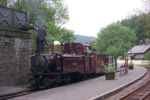
|
1873 | Open | 7 miles 35 chains (11.97 km) | temporary terminus 5 April 1958 to 5 April 1968. |
| Coed y Bleiddiau | Coed y Bleiddiau | 1865? | Open | Approx. 8 miles 40 chains (13.7 km) | private platform serving Coed y Bleiddiau cottage which is only accessible by rail or footpath. | |
| Campbell's Platform | Y Dduallt | 1968 | Open | 9 miles 7 chains (14.62 km) | Private halt serving Plas y Dduallt, a 15th Century Welsh Manor House. | |
| Dduallt | Moel Dduallt | 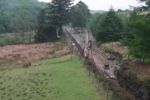
|
1880? | Open | 9 miles 44 chains (15.37 km) | temporary terminus 6 April 1968 to 24 June 1977. |
| Tunnel South loop | Moelwyn Mawr | 1842 | c1865 | Approx. 10 miles (16.1 km) (on former track alignment) | used for passing horse drawn trains and early steam trains. | |
| Tunnel Halt | Moelwyn Mawr | 1920s? | 1939 | 10 miles 60 chains (17.30 km) (on former track alignment) | at the northern end of the old Moelwyn tunnel. | |
| Gelliwiog | Moel Dduallt | 1975 | 1977 | 10 miles 32 chains | temporary terminus of push-pull shuttle trains from Dduallt 26 May 1975 to 24 June 1977. | |
| Llyn Ystradau | Tanygrisiau reservoir | 1977 | 1978 | Approx. 11 miles 30 chains (18.3 km) | temporary terminus 25 June 1977 to 23 June 1978. | |
| Tanygrisiau | Tanygrisiau | 
|
1866 | Open | 12 miles 10 chains (19.51 km) | temporary terminus 24 June 1978 to 24 May 1982. |
| Dinas | Blaenau Ffestiniog | 1865 | 1870 | 13 miles 30 chains (21.52 km) (on branch from current line) | the original northern terminus, opened 6 January 1865. From the opening of Duffws in 1866 until the closure of Dinas in 1870, alternate trains ran along the Dinas and Duffws branches. | |
| Blaenau Ffestiniog (LNWR) | Blaenau Ffestiniog | 
|
1881 | 1939 | 13 miles 25 chains (21.42 km) | ‘Stesion Fein’ (narrow station) - transit station for LNWR/LMS. |
| Blaenau Ffestiniog (GWR) | Blaenau Ffestiniog | 1883 | 1939 | 13 miles 50 chains (21.93 km) (on a different alignment) | joint station with GWR. Terminus from 31 May 1931 until 1939. | |
| Duffws | Blaenau Ffestiniog | 
|
1866 | 1931 | 13 miles 60 chains (22.12 km) (on a different alignment) | only alternate trains ran to Duffws until 1870 when Dinas was closed to passengers. Terminus until 1931. |
| Blaenau Ffestiniog | Blaenau Ffestiniog | 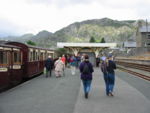
|
1982 | Open | 13 miles 50 chains (21.93 km) | current terminus; joint station with British Rail (Conwy Valley Line) opened 25 May 1982; roughly on site of Blaenau Ffestiniog (GWR) station listed above. |
Note: A different zero point was formerly used in Porthmadog (see below), and the Deviation between Dduallt and Tanygrisiau added half a mile to the line. Mileages have therefore changed. The old mileage to the Duffws terminus, the original start of the line, was 13 miles 32 chains (21.57 km).
At Porthmadog, the original line came via the streets and across the Britannia bridge from the 1836 terminus at the northernmost end of the Welsh Slate Company’s Wharf where the FR officially started. This was the datum point for all pre-1954 mileage calculations. The line over the bridge also connected with the Gorseddau and Croesor Tramways and was used by Welsh Highland Railway passenger trains from 1923 to 1936. The line over the bridge was last used in 1958.
Quarries served by the railway[14]
The Ffestiniog Railway served a cluster of quarries around the town of Blaenau Ffestiniog. Most of these were slate quarries, although granite quarries and zinc mines were also connected by narrow gauge tramways to the railway.
| Name | Opened | Closed | Years connected | Notes |
|---|---|---|---|---|
| Blaen-y-Cwm | 1820 | 1911 | 1876-1911 | Connected to the FfR via the Rhiwbach Tramway |
| Bowydd | 1800 | 1870 | 1854-1870 | Merged with Votty to form Votty & Bowydd quarry |
| Bwlch-y-Slater | 1824 | 1960 | 1866-1956 | Connected via the Rhiwbach Tramway |
| Cesail | 1827 | 1877 | 1836-1877 | Became part of the Oakeley Quarry |
| Conclog | 1872 | 1920? | 1874-1920 | Remote quarry connected by the Cwmorthin Tramway |
| Cwm Orthin | 1810 | 1937 | 1850-1937 | Connected via the Cwmorthin Tramway; became part of the Oakeley quarry in 1900, the two quarries were connected underground |
| Cwt-y-Bugail | 1835 | 1961 | 1867-1961 | Last quarry using the (by then partly lifted) Rhiwbach Tramway |
| Diphyws (Diphwys Casson) | 1760 | 1972 | 1860-1955 | Last of the major quarries to be connected to the Ffestiniog Railway |
| Glan-y-Pwll | 1840s | 1882 | 1867-1882 | Became part of the Oakeley Quarry |
| Groby Granite Quarry | Circa 1932 | 1914-1932(?) | Connected via a short branch worked by FfR locomotives. | |
| Hafodty (Votty) | 1801 | 1870 | 1851-1870 | Joined with Bowydd quarry to form Votty & Bowydd |
| Llechwedd | 1846 | Present | 1848-1980s | Currently worked on a small scale and the site of the Llechwedd Slate Caverns tourist attraction |
| Maenofferen | 1848 | Present | 1848-1975 | Became the major owner of quarries connected via inclines at Duffws station, continued to use the stub of the FfR through Blaenau into the mid 1970s. Untopping operations continue in 2007. |
| Matthews (Rhiwbryfdir) | 1825 | 1871 | 1842-1871 | Became part of the Oakeley quarry |
| Moelwyn | 1826 | 1900 | 1867-1900 | Remote quarry connected to the FfR by a series of seven inclines; worked intermittently and never successfully. |
| Oakeley | 1878 | Present | 1878-1950s | Formed by the amalgamation of the Cesail, Matthews and Glan-y-Pwll quarries. Was the largest single quarry in Blaenau Ffestiniog. Was the home of the Glodfa Ganol tourist attraction in the 1980s and 1990s. Now worked as an open pit by Alfred McApline Ltd. |
| Rhiwbach | 1812 | 1953 | 1860-1953 | Remote quarry situated 4 miles east of Duffws station and connected via the Rhiwbach Tramway |
| Votty & Bowydd | 1870 | 1964 | 1870-1962 | Formed by the amalgamation of the Hafodty and Bowydd quarries. |
| Wrysgan | 1830s | 1946 | 1844-1946 | Connected to the railway near Tanygrisiau via a single long incline ending in a tunnel. |
Train operation since 1955
Infrastructure
As the line was extended, passing loops were brought into operation at Minffordd, Penrhyn and Tan-y-Bwlch. Due to the restrictions to the length of trains that could be passed at Penrhyn, Rhiw Goch was opened on 14 May 1975. Penrhyn loop remained in service for several more years before it was closed. By the end of the 1970s, the passing loops were at Minffordd, Rhiw Goch, Tan-y-Bwlch and Dduallt, and an intensive service was run in the peak summer seasons (although there were empty "slots" in the timetable which could be used by works trains). From the early 1980s, the peak summer timetable had three train sets in operation, generally passing at Rhiw Goch and Dduallt. Automatic signalling was installed at Tan-y-Bwlch in 1986.
As of the 1988 season, in part due to the challenges in maintenance of the top end points at Dduallt, and the planned automation of Minffordd, Dduallt and Rhiw Goch were taken out of service for crossing trains. At the end of May 1988, Dduallt ceased to be a token station and Dduallt loop was taken out of service altogether and became a siding. Rhiw Goch ceased to be used except on odd occasions, and was taken out of use as a means to cross passenger trains in 1989. The short section token instruments and the signal heads were removed, although the loop could still be used as a refuge for engineers trains.
In the late 1990s Rhiw Goch was recommissioned as a passing loop. From the 2005 season, the box has been regularly manned during the summer to provide additional operational flexibility. In 2006 an appeal was launched, through the FR Society, for funds to replace the life-expired signal box with a building of more traditional appearance. Fundraising has gone well and work is scheduled to be done during the closed season of 2006/7. Preparation work, including pouring extensions to the foundation slab, have been carried out during summer 2006.
Elsewhere, Tanygrisiau had been provided with a run-round loop whilst it had been the terminus between June 1978 and May 1982. This loop was removed when the line was re-opened to Blaenau Ffestiniog. In the mid-1990s a project was launched to install a fully signalled passing loop. This proceeded as a volunteer project, including the building of a signal box. However, prior to commissioning, the project was abandoned in 2001. However the trackwork (apart for the siding off the Up Loop) remained in situ. In June 2002, the loop was once again used to run-round trains as part of the 2002 Gala to celebrate the twentieth anniversary of the restoration of services to Blaenau Ffestiniog. The intended platform starter signals (posts, brackets and arms) have been recovered and are now in use on the Isle of Man Railway. In 2004 with new disc starter signals and spring loaded points installed, Tanygrisiau became a passing loop for the first time.
Train control and regulation
The Ffestiniog Railway operates on the Electronic Token System (ETS) using a mixture of miniature and large train staffs, under the overall of the Duty Controller based at Porthmadog.
Miniature train staffs are provided for:-
- Porthmadog to Minffordd (Intermediate Instrument at Boston Lodge)
- Minffordd to Tanybwlch - Long Section (Intermediate Instrument at Rhiw Goch)
- Tanybwlch to Tanygrisiau (Intermediate Instrument at Dduallt)
- Tanygrisiau to Blaenau Ffestiniog
Large train staffs are provided for:-
- Minffordd to Rhiw Goch - Short Section
- Rhiw Goch to Tanybwlch - Short Section
The Short Section train staffs are brought into service by opening Rhiw Goch Signalbox, hence trapping the Minffordd to Tanybwlch Long Section Miniature train staff in the lever frame, when the signal box is opened and manned by a signalman.
The signalling and ETS equipment is primarily designed for train crew operation. To obtain permission to withdraw a train staff to enter a single line section, Control has to be contacted.
The Control Office regulates train running, giving permission for trains to enter the single line sections, recording train movements on the Train Graph, ensuring trains are formed of an appropriate number of carriages (depending on the expected train loadings), acting as the single point of contact in the rare event of a failure occurring with rolling stock, and making station announcements at Porthmadog
The Control Office also is responsible for the Train Operation on the Welsh Highland Railway between Caernarfon and Rhyd Ddu.
Images
Videos
References
- ↑ Festiniog Railway Gravity Trains ed. Peter Johnson (Festiniog Railway Heritage Group, 1986) ISBN 0-949022-00-4 page 4
- ↑ The Festiniog Railway, James I.C. Boyd, 1959, Volume II (page 372)
- ↑ Ffestiniog Railway Magazine (FR Society), No.86, Page 32.
- ↑ Ffestiniog Railway Magazine (FR Society), No.85, Page 22.
- ↑ Ffestiniog Railway Magazine (FR Society), No.90, Page 2
- ↑ Ffestiniog Railway Magazine (FR Society), No.90, Page 6
- ↑ Ffestiniog Railway Magazine (FR Society), No.58, Page 18
- ↑ Ffestiniog Railway Magazine (FR Society), No.87, Page 13
- ↑ Ffestiniog Railway Magazine (FR Society), No.119, Page 13
- ↑ Ffestiniog Railway Company - Offer for Subscription(Prospectus) Ocean Asset Management Ltd, 1987, Page 24
- ↑ Ffestiniog Railway Magazine (FR Society), No.125, Page 191
- ↑ Ffestiniog Railway Magazine (FR Society), No.148, Page 135
- ↑ Ffestiniog Railway Magazine (FR Society), No.163, Page 285
- ↑ Boyd, James I.C. (1975). The Festiniog Railway: Volume 2. The Oakwood Press.
Bibliography
- Ove Arup & Partners; Report on a Rock Fall at Penlan, Ffestiniog Railway, 1979
- E. Beazley; Madocks and the Wonder of Wales, 1967
- R.F. Bleasdale; Spooner Album, 1887, also repub. with commentary by A. Gray, 2003
- D. Blenkinsop; Linda & Blanche 1993
- J.I.C. Boyd; Narrow Gauge Rails to Portmadoc, 1949
- J.I.C. Boyd; On the Welsh Narrow Gauge, no date (1970s)
- J.I.C. Boyd; The Festiniog Railway, 1959, revised edns 1965, 1975
- J. Buck; Discovering Narrow Gauge Railways, 1972
- D.J. Charlton; FR Spotter's Guide; 2001
- C.F. Cliffe; Book of North Wales, 1850
- W.J.K. Davies; Narrow Gauge Railways, 1962
- R. Edwards & P. Moss (eds); Festiniog Railway Historic Drawings, 1997
- R.F. Fairlie; Battle of the Gauges renewed, 1872
- R.F. Fairlie; Locomotive Engines, what they are and what they should be, 1881, reprint 1969
- Ffestiniog Railway Co.; Share prospectus, Traveller's Guides, Stock Books, Guide Books (about 40 in all), 1957-2005
- Festiniog Railway Society; Newsletters 1954-7;
- Ffestiniog Railway Society; FR Magazine, quarterly since 1958
- A. Gray; The Spooner Album, 2003. See also Bleasdale.
- N.F. Gurley; Narrow Gauge Steam out of Portmadoc, 1980
- L. Heath-Humphrys; letter to Railway Gazette, 27 July 1951
- G.T. Heavyside; Narrow Gauge into the 80s, 1980
- B. Hollingsworth; Ffestiniog Adventure, 1981
- F.H. Howson; Narrow Gauge Railways of Britain, 1948
- P.N. Jarvis; Adeiladu Muriau Cerrig Sych - dry stone walling on the Ffestiniog Railway, 1993, revised edn 1995
- P. Johnson; Ffestiniog Railway - a View from the Past, 1997
- P. Johnson; Immortal Rails; the Story of the Closure and Revival of the Ffestiniog Railway 1939-1983 Vol.I 2004, 2004, ISBN 1-900622-08-4 £35; Vol.II 2005 ISBN 1-900622-09-2 £35. Rail Romances, Chester.
- P. Johnson; Portrait of the Ffestiniog, 1992
- P. Johnson; Welsh Narrow gauge; a view from the past, 1992
- P. Johnson; Welsh Narrow Gauge in colour, 1992
- P. Johnson & C.M. Whitehouse; Ffestiniog mewn lliw, 1995
- J.R. Jones & A.Pritchard; Great Little Steam Railways of Wales, 1991
- F. Jux; British Narrow gauge Steam, 1960
- R.W. Kidner; Narrow Gauge Railways of Wales, 1947
- M. Kington; Steaming through Britain, 1990
- C.E. Lee; Narrow Gauge Railways in North Wales, 1945
- M.J.T. Lewis; How Ffestiniog got its Railway, 1965, revised edn 1968
- J.G.V. Mitchell & A.G.W. Garraway; Ffestiniog in the Fifties, 1997
- J.G.V. Mitchell & A.G.W. Garraway; Ffestiniog in the Sixties, 1997
- J.G.V. Mitchell & A.G.W. Garraway; Return to Blaenau 1970-82, 2001
- J.C.V. Mitchell, Smith, Seymour, Gray; Branch lines around Porthmadog, 2 vols, 1993
- F.H. Pole (ed); Welsh Mountain Railways, 1924, reprint 1985
- J.D.C.A. Prideaux; Welsh Narrow Gauge Railway, 1976
- P.J.G. Ransom; Narrow Gauge Steam, 1996
- P.J.G. Ransom; Locomotion, 2001
- A. Roberts; Gossiping Guide to North Wales, 1879 (the 5/- version is much superior to the 6d edition)
- L.J. Roberts; Festiniog & Welsh Highland Holiday book, 1923
- H.R. Schwabe; Mit Volldampf nach Ffestiniog, 1978
- C.E. Spooner; Narrow Gauge Railways, 1871, revised edn 1879
- H. Stretton; Past & Present Companion; Ffestiniog Railway, 1998
- M.J. Stretton; Festiniog Railway in Camera, 1971-1971, revised edn 1999
- 'Taliesin' (C.R.Weaver et al.); Festiniog Railway locomotives, 1988
- J. Timpson; Little Trains of Britain, 1992
- E. Vignes; Étude technique sur le chemin de fer Festiniog, 1878, English translation by Don Boreham 1986
- F.T. Wayne; "When Accounts become misleading Nonsense", Accountancy, November 1961
- P.B. Whitehouse; Festiniog Railway Revival, 1963
- P.B. Whitehouse; Welsh Narrow Gauge Album, 1969
- P.B. Whitehouse & P.C. Allen; Round the World on Narrow Gauge, 1966
- P.B. Whitehouse & P.C. Allen; Narrow Gauge the World over, 1976
- C. Winchester & C.J. Allen,(eds.); Railway Wonders of the World, Vol 2, pp. 1224-28. c. 1938.
- J. Winton; Little Wonder, 1975, revised edn 1986
See also
External links
| Wikimedia Commons has media related to: Ffestiniog Railway |
- The Ffestiniog Railway's website
- The Ffestiniog Railway Society
- Interactive Route Map on Live.com
- Ffestiniog Railway Timetables
- The Festiniog Railway Heritage Group
- The Festiniog Railway Heritage Group's Wiki
| Preceding station | Following station | |||
|---|---|---|---|---|
| Porthmadog | Ffestiniog Railway | Blaenau Ffestiniog | ||
